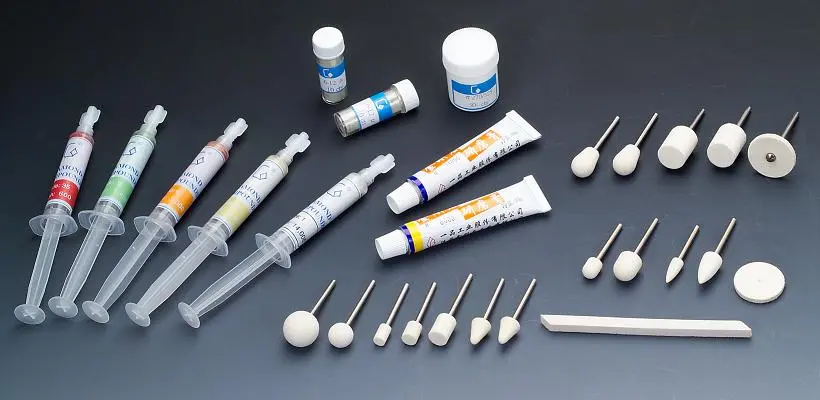Gem Cutting Abrasives in Grit, Mesh, and Microns
Using the right gem cutting abrasives is critical for gem cutters. Our grit, mesh, and micron conversion chart will help you choose the correct material.
2 Minute Read
What Do Grit, Mesh, and Micron Mean?
Grit refers to the size of particles embedded in an abrasive material. The higher the grit, the finer the abrasive. There are different standards for grit used internationally and by manufacturers. For example, just because a polish or compound is labeled as 14,000 grit doesn't mean that all its content is that size. It depends on the methods used to make and grade the compound. Some manufacturers use an average particle size and some use a "nothing larger than" standard, and so on. Read the label or ask the retailer if you're not sure of the standard used.
Mesh refers to the number of evenly spaced holes in a screen per square inch. This refers to a traditional technique used to winnow material through a series of screens with increasingly finer mesh sizes. Particles stopped by a screen of a particular mesh were measured by that mesh number.
A micron is a unit (one 10-6 of a meter) used to measure the size of particles in an abrasive material.
Shopping Advice for Gem Cutting Abrasives
In the United States, most diamond compounds or powders are sold in grit sizes (50,000, 100,000, etc). Aluminum oxide and cerium oxide are usually measured in microns.
In general, the more expensive brands of gem cutting abrasives have better quality control for the sizing and grading of their polishes and compounds. You get what you pay for. Beware of very inexpensive abrasives. They're usually not graded well. It only takes one piece of grit the wrong size to scratch your gemstone and cause problems.
Grit, Mesh, and Micron Conversion Chart
Some of the grits described in the chart below are not commonly available in gem cutting abrasives for various reasons. Nonetheless, they're shown here for conversion purposes. For example, 60,000 grit is the conversion for 0.5 microns, but you'll almost never find it available. 50,000 grit is commonly used.
| Grit (American Standard) | Mesh | Micron | Comments |
| 100,000 | 0-0.5 | 0.25 | Very fine and not used often commercially. Mainly for contest cutting or hobby cutters. Seldom needed. |
| 60,000 | 0-1 | 0.5 | Seldom used. 50,000 grit is more common and used for polishing sapphire and other hard materials. |
| 14,000 | 0-2 | 1 | This is the standard commercial polish for sapphire, although I recommend going another step to 50,000. |
| 13,000 | 1-2 | 1.5 | Seldom used because it's so close to 14,000. |
| 9,000 | 2-3 | 2.5 | Seldom used because it's so close to 8,000. |
| 8,000 | 2-4 | 3 | This is my standard pre-polish for sapphire and other hard materials. |
| 5,000 | 2-6 | 4 | Seldom used. |
| 4,500 | 4-6 | 5 | Seldom used. |
| 2,800 | 5-10 | 7 | Seldom used. 3,000 is commonly used. |
| 1,800 | 6-12 | 9 | Seldom used. |
| 1,400 | 8-20 | 14 | Seldom used. |
| 1,200 | 10-20 | 15 | Seldom used. |
| 1,050 | 12-25 | 18 | Seldom used. |
| 800 | 20-30 | 25 | Seldom used. |
| 600 | 20-40 | 30 | Commonly used for charging copper laps. I prefer plated laps. |
| 500 | 30-40 | 35 | Seldom used. |
| 325 | 40-50 | 45 | Commonly used for charging copper laps. I prefer plated laps. |
| 285 | 50-60 | 55 | Seldom used. |
| 240 | 60-80 | 70 | Seldom used. 260 is commonly used for charging copper laps. I prefer plated laps. |
| 225 | 80-100 | 90 | Commonly used for charging copper laps. I prefer plated laps. |
| 160 | 100-120 | 110 | Seldom used. |
| 100 | 120-160 | 150 | Commonly used for charging copper laps. I prefer plated laps. |
Jeff R. Graham
The late Jeff Graham was a prolific faceter, creator of many original faceting designs, and the author of several highly-regarded instructional faceting books such as Gram Faceting Designs.
Related Articles
Ultra Tec Faceting Machine Factory
How to Measure Gem Girdle Thickness
Several Ways to Polish Sapphires
How to Identify Synthetic Rough in Gemstone Parcels
Latest Articles
800 Years of Mogok: A Celebration in Tenuous Times
What is the Average Gemstone Faceting Yield?
Pyroxmangite Value, Price, and Jewelry Information
How to Identify Emerald Simulants and Synthetics
Never Stop Learning
When you join the IGS community, you get trusted diamond & gemstone information when you need it.
Get Gemology Insights
Get started with the International Gem Society’s free guide to gemstone identification. Join our weekly newsletter & get a free copy of the Gem ID Checklist!
